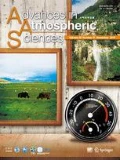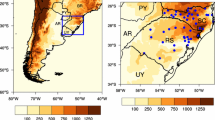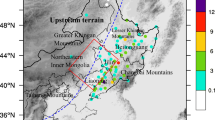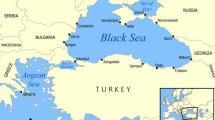Abstract
A 24-h simulation with the Advanced Regional Prediction System (ARPS) nonhydrostatic model is performed for the heavy snowfall event of 3–4 February 1998 along the eastern coast of Korean Peninsula; the results are used to understand the snowfall process, including why the precipitation maxima formed along the Yeongdong coastal region rather than over the mountain slope and ridge top during.
The numerical simulation with a 4-km horizontal grid spacing and 43 levels reproduces very well the narrow snowband located off the eastern Korean coast, away from, instead of over, the Yeongdong coastal mountain range. The general evolution of the snowband agrees quite well with radar observations, while the water-equivalent precipitation amount agrees reasonably well with radar precipitation estimate. The simulation results clearly show that the snow band developed due to the lifting by a coastal front that developed because of the damming of cold air against the eastern slope of the coastal mountain range. The damming was enhanced by the advection of cold air by a low-level mountain-parallel jet from the north, formed due to geostrophic adjustment as the on-shore upslope air was decelerated by the mountain blocking. As the onshore flow weakened later due to synoptic-scale flow pattern change, the cold front propagated off shore and the precipitation dissipated.
Similar content being viewed by others
References
Atlas, D., S-H. Chou, and W. P. Byerly, 1983: The in-fluence of coastal shape on winter meso-scale air-sea interaction. Mon. Wea. Rev., 111, 245–252.
Baines, P. G., 1979: Observations of stratified flow past three-dimensional barriers. J. Geophys. Res., 84, 7834–7838.
Bell, D. G., and L. F. Bosart, 1988: Appalachian cold-air damming. Mon. Wea. Rev., 116, 137–162.
Bosart, L. F., 1975: New England coastal frontogenesis. Quart. J. Roy. Meteor. Soc., 101, 957–978.
Bosart, L. F., 1981: The President’s Day snowstorm of 18–19 February 1979: A subsynoptic-scale event. Mon. Wea. Rev., 109, 1542–1566.
Bosart, L. F., D. J. Vaudo, and J. H. Heldson Jr., 1972: Coastal frontogenesis. J. Appl. Meteor., 11, 1236–1258.
Chen, T. C., C. B. Chang, and D. J. Perkey, 1983: Numerical study of an AMTEX 75 oceanic cyclone. Mon. Wea. Rev., 111, 1818–1829.
Eichenlaub, V. L., 1979: Weather and Climate of the Great Lakes Region. University of Notre Dame Press, 335pp.
Estoque, M. A., and K. Ninomiya, 1976: Numerical simulation of Japan Sea effect snowfall. Tellus, 28, 243–253.
Forbes, G. S., R. A. Anthes, and D. W. Thomson, 1987: Synoptic and mesoscale aspects of an Appalachian ice storm associated with cold-air damming. Mon. Wea. Rev., 115, 564–591.
Hjelmfelt, M. R., and R. R. Braham Jr., 1983: Numerical simulation of the air flow over Lake Michigan for a major lake-effect snow event. Mon. Wea. Rev., 111, 205–219.
Jhun, J.-G, D.-K. Lee, and H.-A. Lee, 1994: A study on the heavy snowfalls occurred in South Korea. J. Korean Meteor. Soc., 30, 97–117. (in Korean with English abstract)
Kitabayshi, K., 1977: Wind tunnel and field studies of stagnant flow upstream of a ridge. J. Meteor. Soc. Japan, 55, 193–203.
KMA, 1996: A new numerical weather prediction system at KMA. Technical Report 96-2, 147pp. (in Korean)
Lee, H., and T.-Y. Lee, 1994: The governing factors for heavy snowfalls in Youngdong area. J. Korean Meteor. Soc., 30, 197–218. (in Korean with English abstract)
Lee, J. G., 1999: Synoptic structure causing the difference in observed snowfall amount at Taegwallyong and Kangnung. Asia-Pacific Journal of Atmospheric Sciences, 35, 319–334. (in Korean with English abstract)
Lee, J. G., and Y. J. Kim, 2008: A numerical simulation study using WRF of a heavy snowfall event in the Yeongdong coastal area in relation to the northeasterly. Atmosphere, 18, 339–354. (in Korean with English abstract)
Lee, J. G., S.-D. Kim, and Y.-J. Kim, 2011: A trajectory study on the heavy snowfall phenomenon in Yeongdong region of Korea. Asia-Pacific Journal of Atmospheric Sciences, 47, 45–62.
Lin, Y.-L., R. D. Farley, and H. D. Orville, 1983: Bulk parameterization of the snow field in a cloud model. J. Climate Appl. Meteor., 22, 1065–1092.
Mason, P. J., and R. I. Skyes, 1978: On the interaction of topography and Ekman boundary layer pumping in a stratified atmosphere. Quart. J. Roy. Meteor. Soc., 104, 475–490.
Nagata, M., M. Ikawa, S. Yoshizumi, and T. Yoshida, 1986: On the formation of a convergent cloud band over the Japan sea in winter: Numerical experiments. J. Meteor. Soc. Japan, 64, 841–855.
Ninomiya, K., 1968: Heat and water budget over the Japan sea and the Japan islands in winter season. J. Meteor. Soc. Japan, 46, 343–372.
Niziol, T. A., W. R. Snyder, and J. S. Waldstreicher, 1995: Winter weather forecasting throughout the eastern United States. Part IV: Lake effect snow. Wea. Forecasting, 10, 61–77.
Noilhan, J., and S. Planton, 1989: A simple parameterization of land surface processes for meteorological models. Mon. Wea. Rev., 117, 536–549.
Ren, D., and M. Xue, 2004: A revised force-restore model for land-surface modeling. J. Appl. Meteor., 43, 1768–1782.
Richwien, B. A., 1980: The damming effect of the southern Appalachians. Natl. Wea. Dig., 5, 2–12.
Rotunno, R., J. B. Klemp, and M. L. Weisman, 1988: A theory for strong long-lived squall lines. J. Atmos. Sci., 45, 463–485.
Sanders, F., and J. R. Gyakum, 1980: Synoptic dynamic climatology of the bomb. Mon. Wea. Rev., 108, 1589–1606.
Seo, E.-K., and J.-G. Jhun, 1991: A case study of the heavy snowfalls occurred in the Korean peninsula from 29 January to 1 February 1990. J. Korean Meteor. Soc., 27, 165–179. (in Korean with English abstract)
Skamarock, W. C., J. B. Klemp, J. Dudhia, D. O. Gill, D. M. Barker, W. Wang, and J. D. Powers, 2005: A Description of the advanced research WRF version 2, NCAR Tech. Note NCAR/TN-468+STR, 88pp.
Stauffer, D. R., and T. T. Warner, 1987: A numerical study of Appalachian cold-air damming and coastal frontogenesis. Mon. Wea. Rev., 115, 799–821.
Waldstreicher, J. S., 2002: A foot of snow from a 3000-foot cloud-The ocean-effect snowstorm of 14 January 1999. Bull. Amer. Meteor. Soc., 83, 19–22.
Xu, Q., 1990: A theoretical study of cold-air damming. J. Atmos. Sci., 47, 2969–2985.
Xu, Q., and S. Gao, 1995: An analytic model of cold air damming and its applications. J. Atmos. Sci., 52, 353–366.
Xue, M., K. K. Droegemeier, V. Wong, A. Shapiro, and K. Brewster, 1995: ARPS Version 4.0 User’s Guide. [Available online at http://www.caps.ou.edu/ARPS.]
Xue, M., K. K. Droegemeier, and V. Wong, 2000: The Advanced Regional Prediction System (ARPS)-A multiscale nonhydrostatic atmospheric simulation and prediction tool. Part I: Model dynamics and verification. Meteor. Atmos. Phys., 75, 161–193.
Xue, M., and Coauthors, 2001: The Advanced Regional Prediction System (ARPS)-A multi-scale nonhydrostatic atmospheric simulation and prediction tool. Part II: Model physics and applications. Meteor. Atmos. Phys., 76, 143–166.
Xue, M., D.-H. Wang, J.-D. Gao, K. Brewster, and K. K. Droegemeier, 2003: The Advanced Regional Prediction System (ARPS), storm-scale numerical weather prediction and data assimilation. Meteor. Atmos. Phys., 82, 139–170.
Author information
Authors and Affiliations
Corresponding author
Rights and permissions
About this article
Cite this article
Lee, JG., Xue, M. A study on a snowband associated with a coastal front and cold-air damming event of 3–4 February 1998 along the eastern coast of the Korean Peninsula. Adv. Atmos. Sci. 30, 263–279 (2013). https://doi.org/10.1007/s00376-012-2088-6
Received:
Revised:
Published:
Issue Date:
DOI: https://doi.org/10.1007/s00376-012-2088-6




